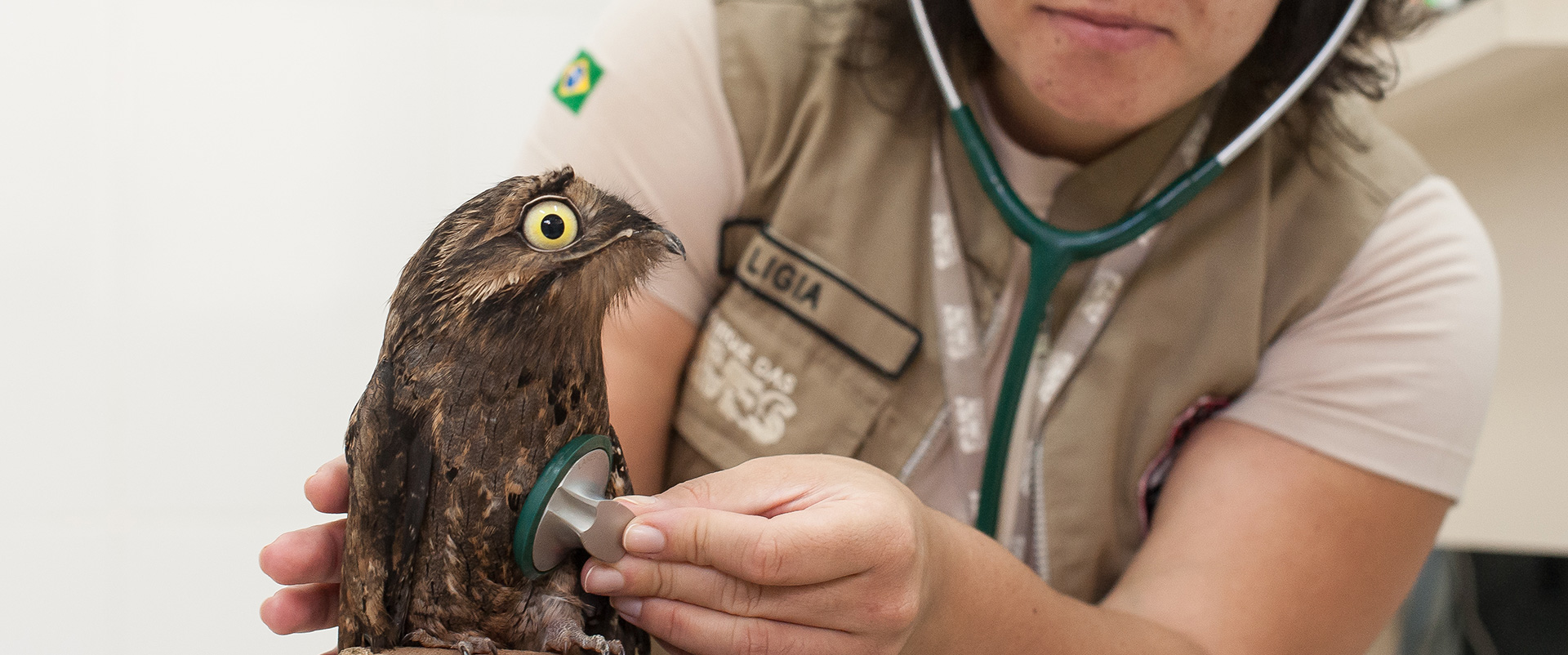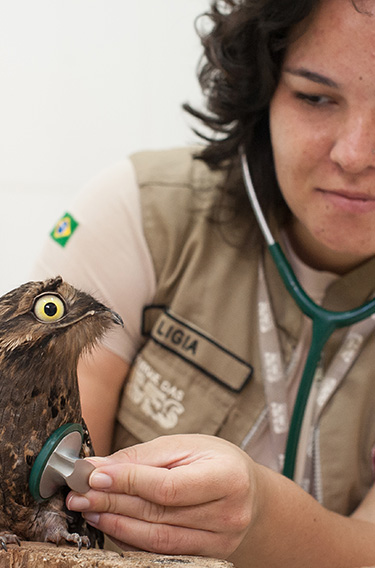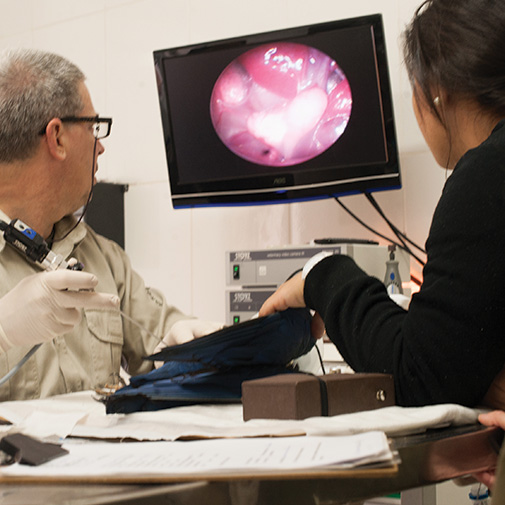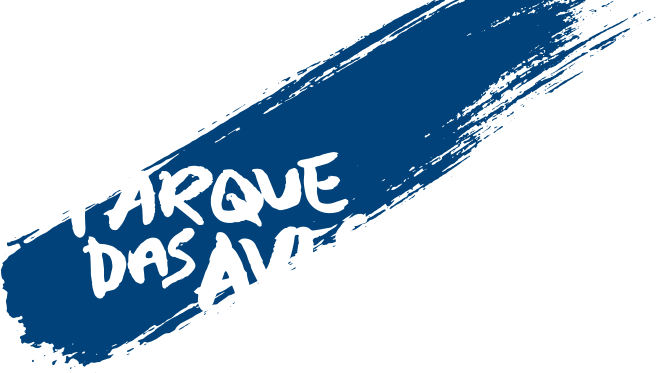


THE VETERINARY SECTOR AND THE ATLANTIC RAINFOREST BIRDS
The structure of the Parque das Aves Veterinary Hospital includes a clinic, a laboratory, a sterilization room, a 24-hour care room, and a medications storage room. Several procedures are done in the clinic such as first-aid care, medications, collections for various exams, and the place is equipped with an inhalation anesthesia device, scales, endoscope, a portable X-Ray machine, and an image scanner). In this environment a wide variety of medications are available such as analgesia, antibiotics, anti-inflammatories, and antifungals. The laboratory has a structure for performing various tests such as a microscope for reading complete blood count, cytology, bacteriology, and stool examination (coproparasitological); kiln for microbiology exams that consider a commercial kit for identifying bacteria and antibiogram; capillary centrifuge for hematocrit and refractometer for reading total protein plus a device to perform blood biochemistry that can evaluate the liver function, renal function, and electrolyte doses. These diagnostic tools are of great importance in clinical practice because they can help our team in targeting treatments and diagnosing diseases. There is also an on-site autoclave for sterilization of all surgical material used in the Veterinary Medicine Division. The 24-hour care room has dozens of cages of varying sizes in which the sick animals are comfortably accommodated, spending their entire treatment time under constant observation by the team.

 |
THE VETERINARY SECTOR AND THE ATLANTIC RAINFOREST BIRDS |

The structure of the Parque das Aves Veterinary Hospital includes a clinic, a laboratory, a sterilization room, a 24-hour care room, and a medications storage room. Several procedures are done in the clinic such as first-aid care, medications, collections for various exams, and the place is equipped with an inhalation anesthesia device, scales, endoscope, a portable X-Ray machine, and an image scanner). In this environment a wide variety of medications are available such as analgesia, antibiotics, anti-inflammatories, and antifungals. The laboratory has a structure for performing various tests such as a microscope for reading complete blood count, cytology, bacteriology, and stool examination (coproparasitological); kiln for microbiology exams that consider a commercial kit for identifying bacteria and antibiogram; capillary centrifuge for hematocrit and refractometer for reading total protein plus a device to perform blood biochemistry that can evaluate the liver function, renal function, and electrolyte doses. These diagnostic tools are of great importance in clinical practice because they can help our team in targeting treatments and diagnosing diseases. There is also an on-site autoclave for sterilization of all surgical material used in the Veterinary Medicine Division. The 24-hour care room has dozens of cages of varying sizes in which the sick animals are comfortably accommodated, spending their entire treatment time under constant observation by the team.
An important assignment given to the Park’s veterinarian team is receiving the animals who arrive to live at the Park. These animals undergo an average quarantine period of 45 days with occasional variations as recommended for the species. Parque das Aves adopts different protocols depending on the group to which the species belongs. During this period, the animals remain isolated and several exams are carried out. This quarantine procedure is an important measure of biosafety because its aim is the early detection and control of diseases that may cause health risks from these and other animals that are at Parque das Aves. This is the time when biological samples are collected for laboratory exams designed to check the state of health of each individual. The exams routinely done on the animals in quarantine at Parque das Aves are as follows: a complete blood count, serum biochemistry, coproparasitological exam, culture of feces, test for ectoparasites and hemoparasites, and PCR tests (molecular biology). Other tests can be performed such as x-rays, endoscopies, and biopsies whenever necessary. Parque das Aves has two buildings used for receiving animals, the main quarantine building located 3.5 km from the Park, and other auxiliary one, detached from the visitor area, but within the premises of Parque das Aves. The support quarantine receives animals with greater need for veterinary care such as chicks and/or sick animals delivered by environmental agencies due to the proximity with the Veterinary Medicine Division, and the Main Quarantine Building receives all other animals coming to the Park. The two sites, one of 70 m² and the other of 140 m² used for quarantine are built of masonry in which there is a place for the attendants to put on sterile gowning who carry out the daily management of the animals with a unidirectional flow and a clinic for veterinary care exclusively for the animals kept there.
The Veterinary Medicine Division has a necropsy room located in an area outside the place of care for assessing and collecting the samples needed to establish the animal’s cause of death. This room is equipped with specific material that allows collecting tissue samples and other materials during the necroscopic exam to later send to diagnostic laboratories that perform examinations of histopathology and PCR, for example.
CLICK ON THE LINKS BESIDE AND LEARN MORE
CLICK ON THE LINKS BELOW AND LEARN MORE
HOME PROJECTS
> BLUE-FRONTED AMAZON
> RED-BROWED AMAZON
> BIRDS OF IGUAÇU
> PARTNERSHIPS
> SHELTER AND RECOVERY
> REHABILLITATION
> REPRODUCTIVE MANAGEMENT
> REPRODUCTION FOR CONSERVATION
> BEHAVIOR AND WELFARE
> NUTRITION
> STRATEGIC COMMUNICATION FOR CONSERVATION
> AMBIENTAL EDUCATION AND SOCIAL SCIENCE
SOS FAUNA
RED-SPECTACLED AMAZON PARROT PROJECT
PARROTS AT THE GRAMADÃO SQUARE
> RESEARCH
> THE VETERINARY SECTOR AND THE ATLANTIC RAINFOREST BIRDS
> CONSERVATION BIOLOGY, ZOOLOGY, AND VETERINARIAN IN THE FIELD
 Every day from 8:30am to 5:30pm
Every day from 8:30am to 5:30pm Prices
Prices


